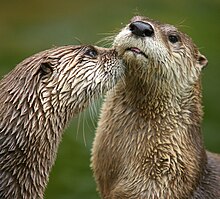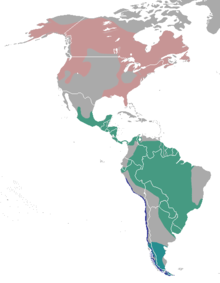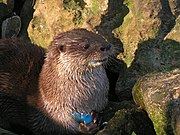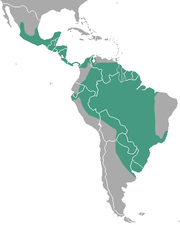
The Mustelidae are a diverse family of carnivorous mammals, including weasels, stoats, badgers, otters, martens, grisons, and wolverines. Otherwise known as mustelids, they form the largest family in the suborder Caniformia of the order Carnivora with about 66 to 70 species in nine subfamilies.

Otters are carnivorous mammals in the subfamily Lutrinae. The 13 extant otter species are all semiaquatic, aquatic, or marine. Lutrinae is a branch of the Mustelidae family, which includes weasels, badgers, mink, and wolverines, among other animals.

Hagerman is a city in Gooding County, Idaho, United States. The population was 872 at the 2010 census, up from 656 in 2000. The area is noted for its fossil beds and the Thousand Springs of the Eastern Snake Plain Aquifer. Hagerman is home to a national fish hatchery, a university research station, and extensive aquaculture, assisted by an abundance of geothermal water for temperature regulation.

The South American foxes (Lycalopex), commonly called raposa in Portuguese, or zorro in Spanish, are a genus from South America of the subfamily Caninae. Despite their name, they are not true foxes, but are a unique canid genus more closely related to wolves and jackals than to true foxes; some of them resemble foxes due to convergent evolution. The South American gray fox, Lycalopex griseus, is the most common species, and is known for its large ears and a highly marketable, russet-fringed pelt.

Caniformia is a suborder within the order Carnivora consisting of "dog-like" carnivorans. They include dogs, bears, raccoons, and mustelids. The Pinnipedia are also assigned to this group. The center of diversification for the Caniformia is North America and northern Eurasia. Caniformia stands in contrast to the other suborder of Carnivora, the Feliformia, the center of diversification of which was in Africa and southern Asia.

The North American river otter, also known as the northern river otter and river otter, is a semiaquatic mammal that lives only on the North American continent, along its waterways and coasts. An adult North American river otter can weigh between 5.0 and 14 kg. The river otter is protected and insulated by a thick, water-repellent coat of fur.
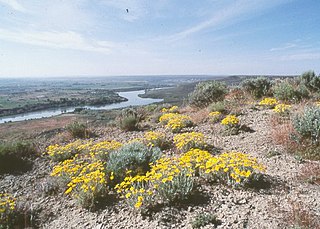
Hagerman Fossil Beds National Monument is a Pliocene-age site near Hagerman, Idaho. The 4,351-acre (17.61 km2) Monument is internationally significant because it protects one of the richest known fossil deposits from the Blancan North American Land Mammal Age. These fossils date from 3.07 million to at least 4 million years ago in age and represent at least 200 species. Hagerman is best known for having the largest known concentration of the fossil horse, Equus simplicidens. The fossil beds, including the historic Smithsonian Horse Quarry, were designated a National Natural Landmark in 1975 and was reclassified as a National Monument in 1988.

The giant otter or giant river otter is a South American carnivorous mammal. It is the longest member of the weasel family, Mustelidae, a globally successful group of predators, reaching up to 1.8 m. Atypical of mustelids, the giant otter is a social species, with family groups typically supporting three to eight members. The groups are centered on a dominant breeding pair and are extremely cohesive and cooperative. Although generally peaceful, the species is territorial, and aggression has been observed between groups. The giant otter is diurnal, being active exclusively during daylight hours. It is the noisiest otter species, and distinct vocalizations have been documented that indicate alarm, aggression, and reassurance.

The Neotropical otter or Neotropical river otter is an otter species found in Mexico, Central America, South America, and the island of Trinidad. It is physically similar to the northern and southern river otter, which occur directly north and south of this species' range. Its head-and-body length can range from 36–66 centimetres (14–26 in), plus a tail of 37–84 centimetres (15–33 in). Body weight ranges from 5–15 kilograms (11–33 lb). Otters are members of the family Mustelidae, the most species-rich family in the order Carnivora.

The marine otter is a rare and relatively unknown South American mammal of the weasel family (Mustelidae). The scientific name means "feline otter", and in Spanish, the marine otter is also often referred to as gato marino: "marine cat". The marine otter only lives in saltwater, coastal environments and rarely ventures into fresh water or estuarine habitats. This saltwater exclusivity is unlike most other otter species, except for the almost fully aquatic sea otter of the North Pacific.

Aonyx is a genus of otters, containing three species, the African clawless otter, the Congo clawless otter, and the Asian small-clawed otter. The word aonyx means "clawless", derived from the prefix a- ("without") and onyx ("claw/hoof").
Potamotherium an extinct genus of caniform carnivoran from the Miocene epoch of France and Germany. It has historically been assigned to the family Mustelidae, but more recent studies suggest that it represents a primitive relative of pinnipeds

Feliformia is a suborder within the order Carnivora consisting of "cat-like" carnivorans, including cats, hyenas, mongooses, viverrids, and related taxa. Feliformia stands in contrast to the other suborder of Carnivora, Caniformia.
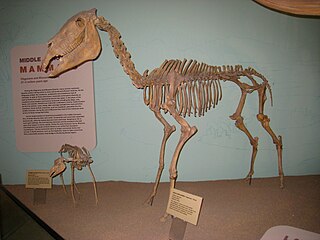
Equus simplicidens, sometimes known as the Hagerman horse or the American Zebra is an extinct species of equine native to North America during the Pliocene and Early-Late Pleistocene. It is one of the oldest and most primitive members of the genus Equus. Abundant remains of it were discovered in 1928 in Hagerman, Idaho. It is the state fossil of Idaho.

Megalictis is an extinct genus of large predatory mustelids that existed in North America during the "cat gap" from the Late Arikareean (Ar4) in the Miocene epoch. It is thought to have resembled a huge, jaguar-sized ferret, weighing up to 60–100 kilograms (130–220 lb).

Ysengrinia is an extinct genus of carnivoran in the family Amphicyonidae (beardogs), which lived in Europe, Asia, and North America during the Early Miocene. It was also reported from Egypt and Namibia, but this material has been reassigned to other genera of beardogs.

Enhydriodon is an extinct genus of mustelids known from Africa, Pakistan and India that lived from the late Miocene to the early Pleistocene. It contains 9 confirmed species, 2 debated species, and at least a few other undescribed species from Africa. The genus belongs to the tribe Enhydriodontini in the otter subfamily Lutrinae. Enhydriodon means "otter tooth" in Ancient Greek and is a reference to its dentition rather than to the Enhydra genus, which includes the modern sea otter and its two prehistoric relatives.
Lontra weiri is a fossil species in the carnivoran family Mustelidae from the Hagerman Fossil Beds of Idaho. It shared its habitat with Satherium piscinarium, a probable ancestor of the giant otter of South America. It is named in honor of musician Bob Weir, and is the oldest known member of its genus. Prior to its discovery, Lontra was thought to have evolved from Lutra licenti, which dates from the Pleistocene of East Asia.

Enhydrictis is a genus of extinct mustelid, belonging to the subfamily Galictinae. The type species, and best known, is Enhydrictis galictoides from the Pleistocene of Sardinia and Corsica. Some authors attribute species from mainland Eurasia to the genus, but this is disputed, with others considering the genus endemic to Sardinia-Corsica.
